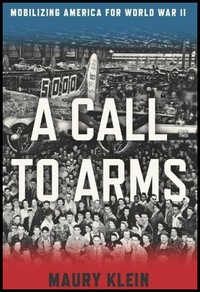Short-listed for the 2014 Phi Beta Kappa Ralph Waldo Emerson Award
By Kayleigh Whitman
For a historian, the question of where to begin the story of American mobilization for World War II could be answered in many ways. Maury Klein chose to begin his impressive work at the 1939 World’s Fair in Flushing Meadows, New York—a romantic moment showcasing America’s hopes for the future of progress and technology. America’s industry would have to take a detour on the way to their gleaming futuristic city though; for just months after the fair opened, Germany marched into Poland, signaling the official start of arguably the most devastating conflict of the twentieth century. Over the next six years of warfare the world would see just how important technology had become in battle, and the United States especially, would realize that the progress promised at the World’s Fair would become necessary for their survival.
A Call to Arms: Mobilizing America for World War II recounts the people and events that prepared this country’s industry for a new type of war and the difficulties they encountered. Klein explains that the United States did not easily arrive at the powerful position they assumed in the war, but rather had to be navigated by the political prowess of FDR and other major players both within and outside of Washington, D.C. Though a great number of Americans believed that the U.S. should observe a policy of isolationism, many in Washington knew that America could not afford to let their military production lie idle. Klein shows the reader that the United States’ involvement in this conflict began years before the Japanese attack, as major companies began rolling out thousands of airplanes, ammunition, and weapons. These were at first built to aid Britain and the Allies, but later became part of the American defense.
In order to make this grand undertaking an effective one, Klein shows that new relationships between the government and industry had to be forged; as well as new relationships between business leaders. The Aircraft War Production Council, for instance, brought together eight airplane manufacturers who shared their technologies and techniques in the interest of fulfilling production demands. Competition amongst them fell to the wayside. The full picture of the national efforts required for American success in World War II is evident through examples such as this, and are present throughout the entire book.
One of the first things the reader will notice about the book is its imposing size. There is no denying that A Call to Arms is lengthy, but the reader should not be intimidated. In addition to his engaging writing style, Klein has also crafted the book in a way that is easy for readers to read straight through, or leave and return at their leisure. The text covers the years of 1940-1945, meaning that it explains the crucial years before the bombing of Pearl Harbor and America’s official entrance in to the war. Each year is awarded its own section and title such as “1942: The Year of Despair”. Maintaining a comprehensive thesis throughout a book of this length can be difficult; the reader can sometimes get lost. However, these sections provide a theme for each year, allowing the reader to get a better grasp of the material Klein is presenting to them. It also makes each unit comprehensive on its own. Readers can dive right into “1941: The Year of Turmoil” and get a real understanding of the struggles between labor leaders of the AFL and CIO or the creation of emergency ship contracts—all of which are part of the larger difficulties of mass mobilization.
Within each of these chapters Klein uses narratives to tell much of the history. Readers will see some familiar characters such as President Franklin D. Roosevelt and Secretary of War Henry Stimson, but they will also follow the stories of lesser-known players. One of these “unsung heroes” was Stacy May, a statistician who served as the first head of National Defense Advisory Commission’s Bureau of Research Statistics. Acting as an agent of the War Department, May travelled to Britain and created an in-depth balance sheet of supply planning for both British and American troops. The United States’ planners were able to use this information to determine the ideal level of output for any supplies. In the same way that these men drove American production, their stories drive this volume.
The subject of A Call to Arms is integral to the understanding of the United States’ experience in World War II. Maury Klein has not only created the first truly comprehensive account of these events, but he has done so in a way that is compelling and enjoyable. Further, he has shown that there is still much that can be explored in the history of twentieth century America.
Kayleigh Whitman (ΦBK, Florida State University, 2014) graduated from Florida State University with a degree in history. She is currently a graduate student in the history department at Brandeis University (Mu of Massachusetts Chapter).




